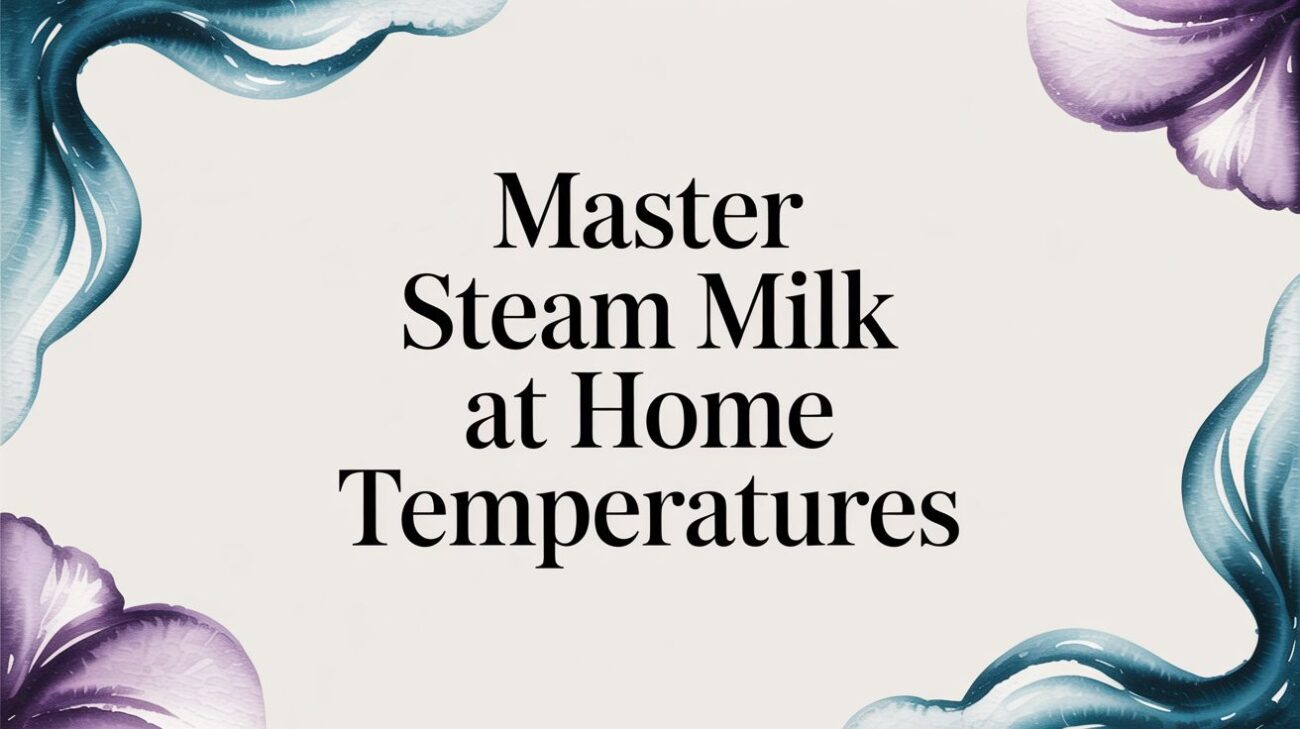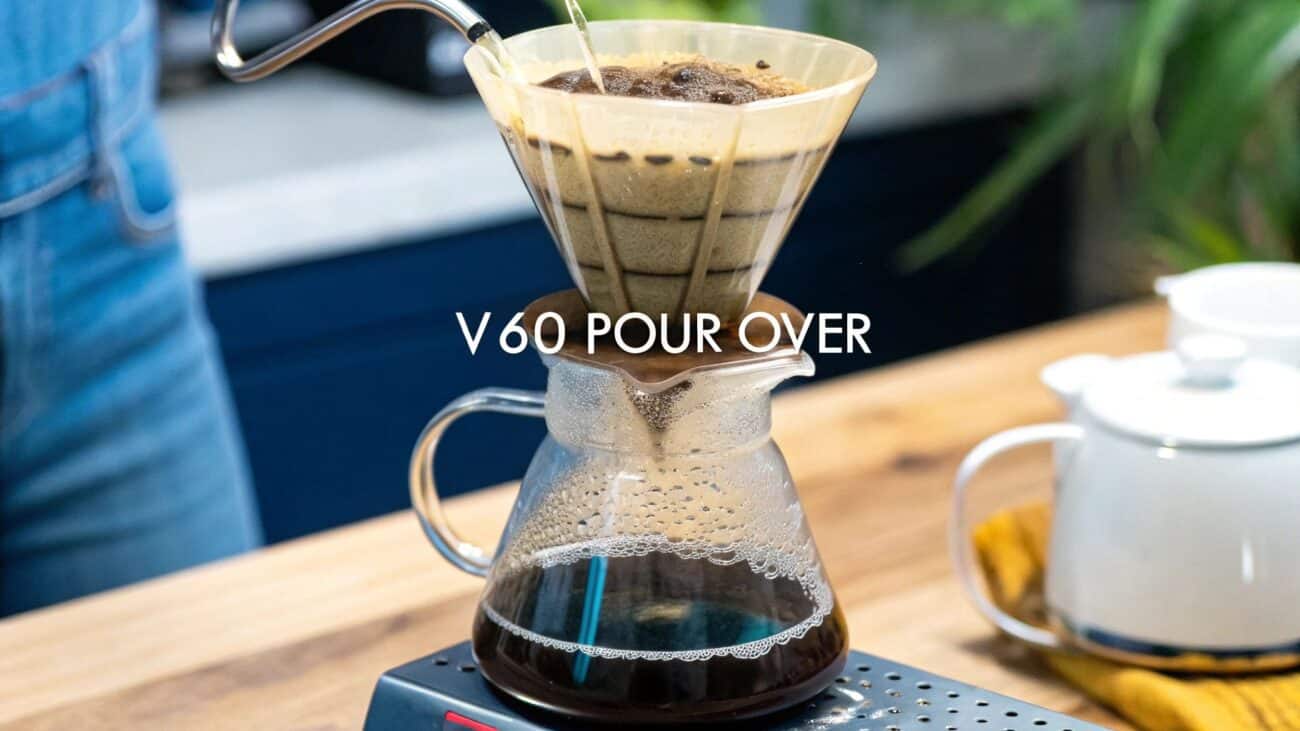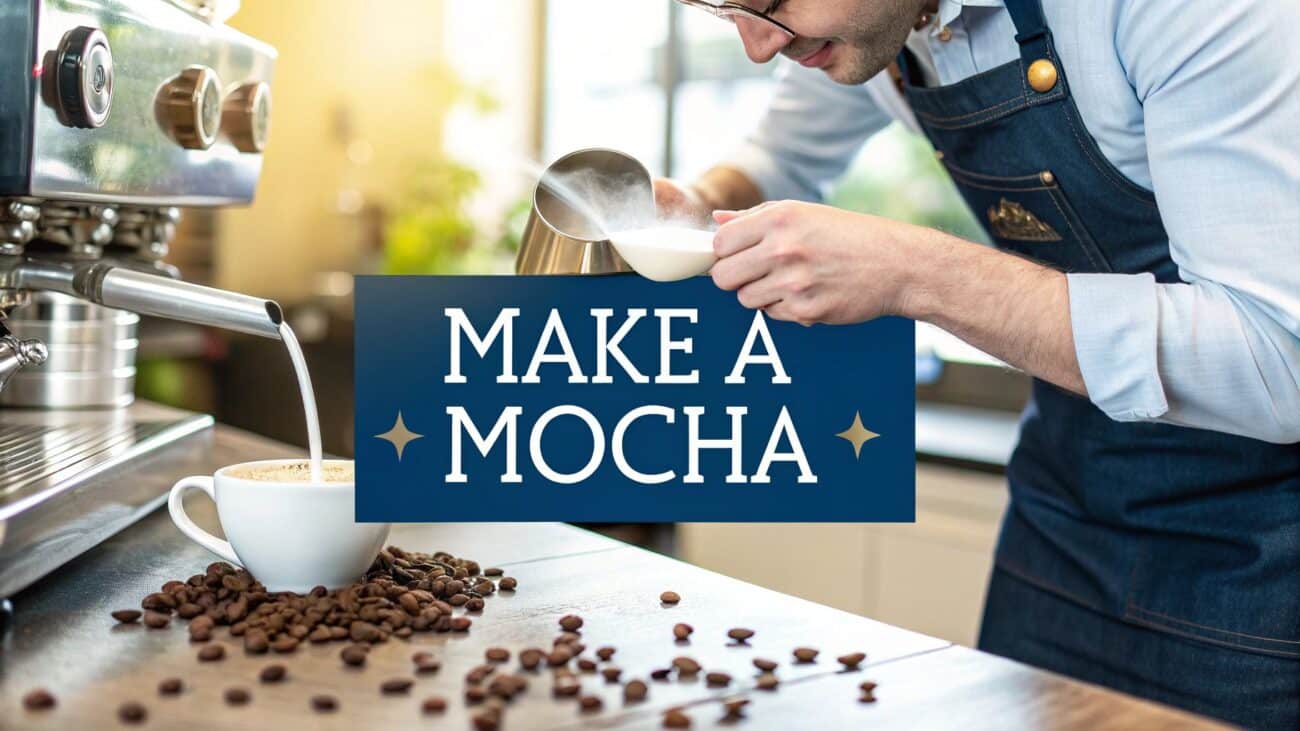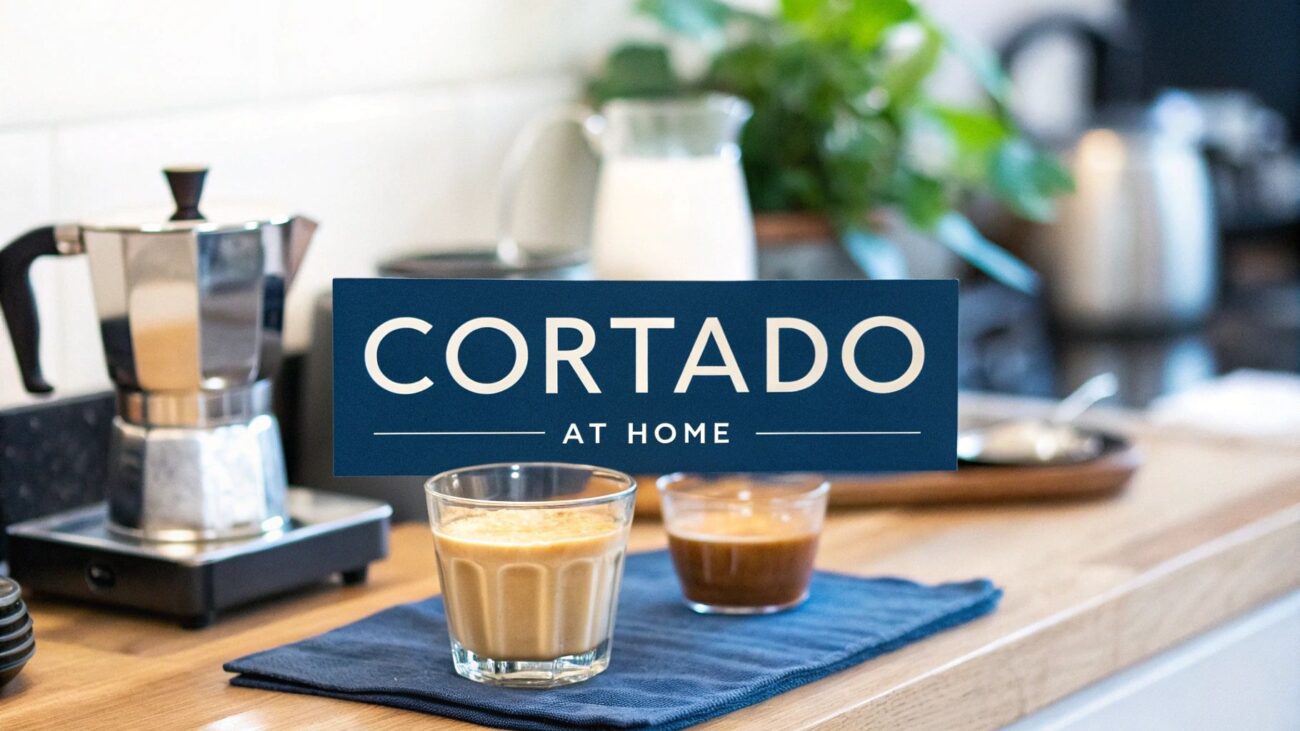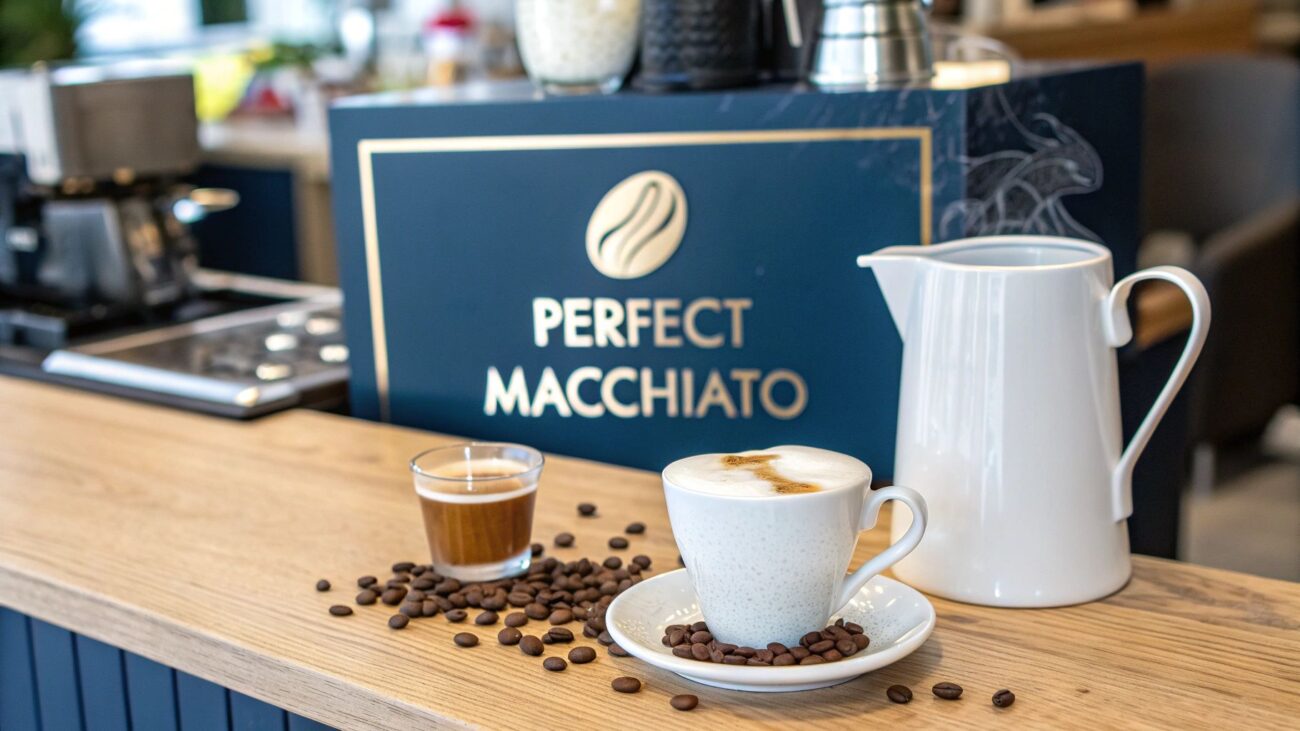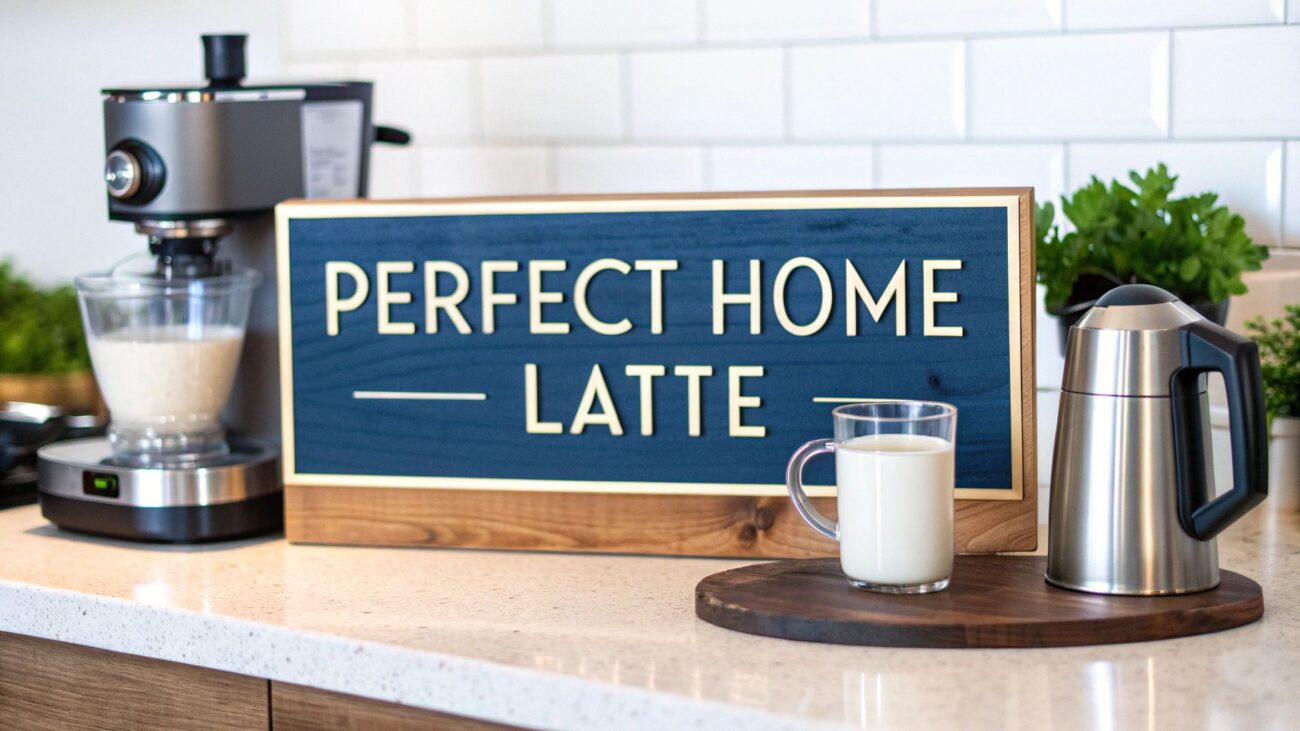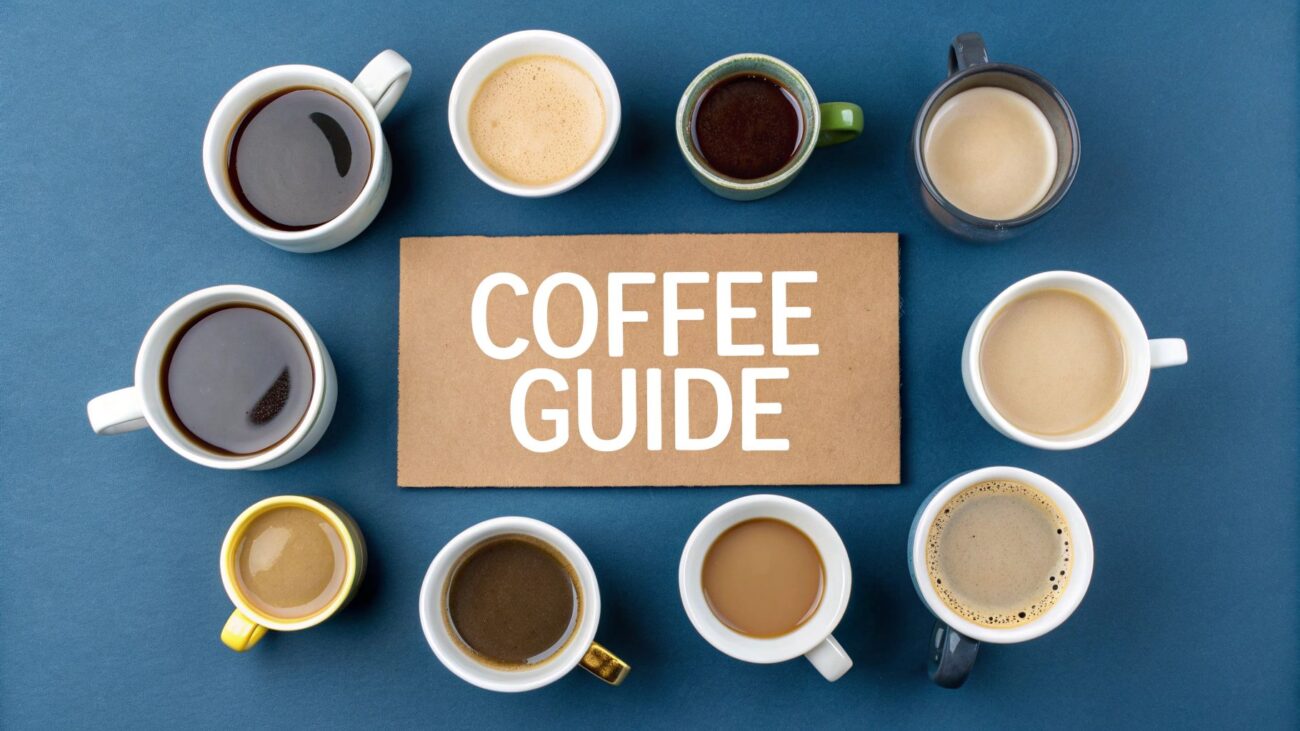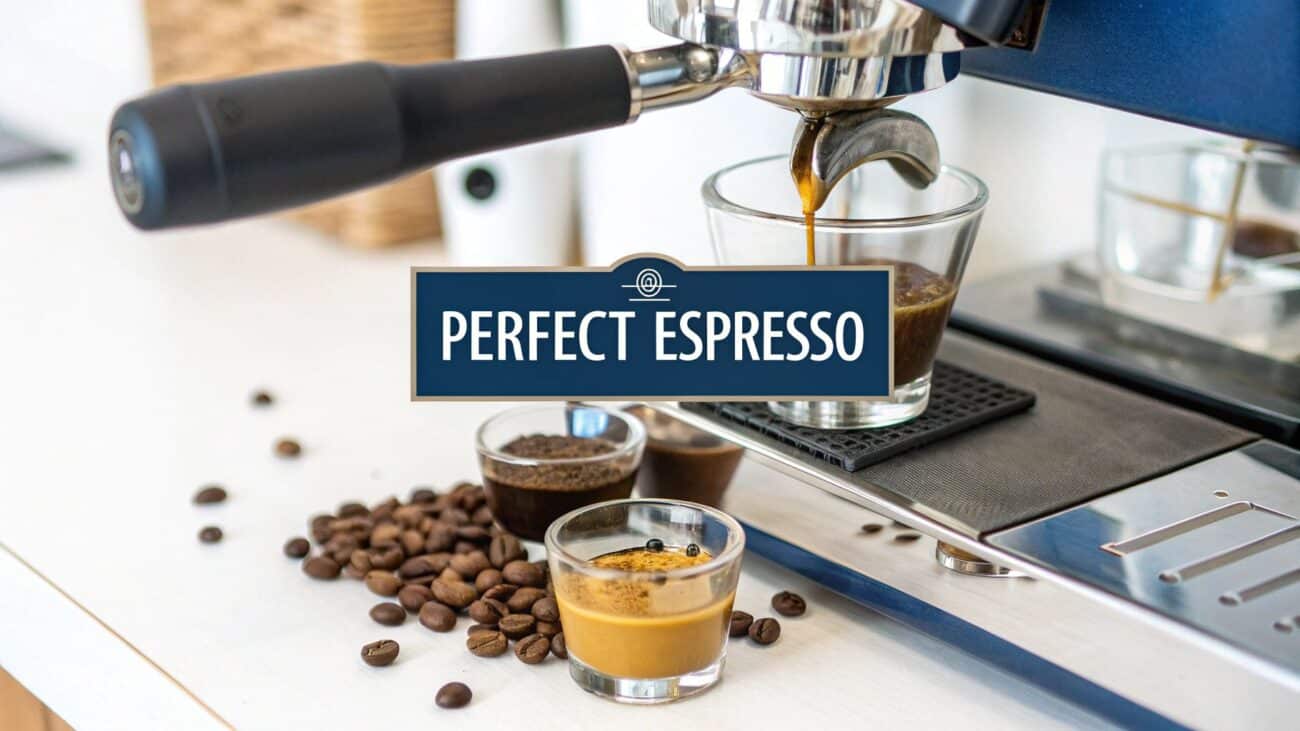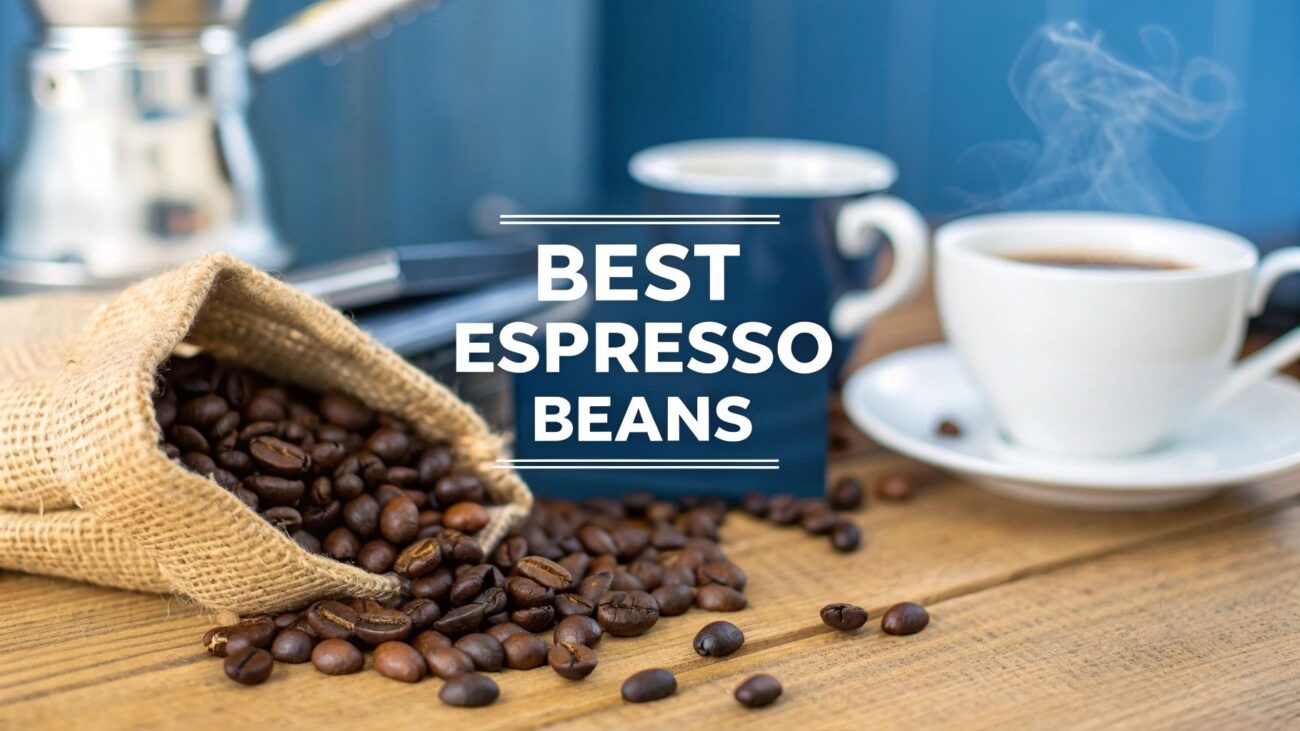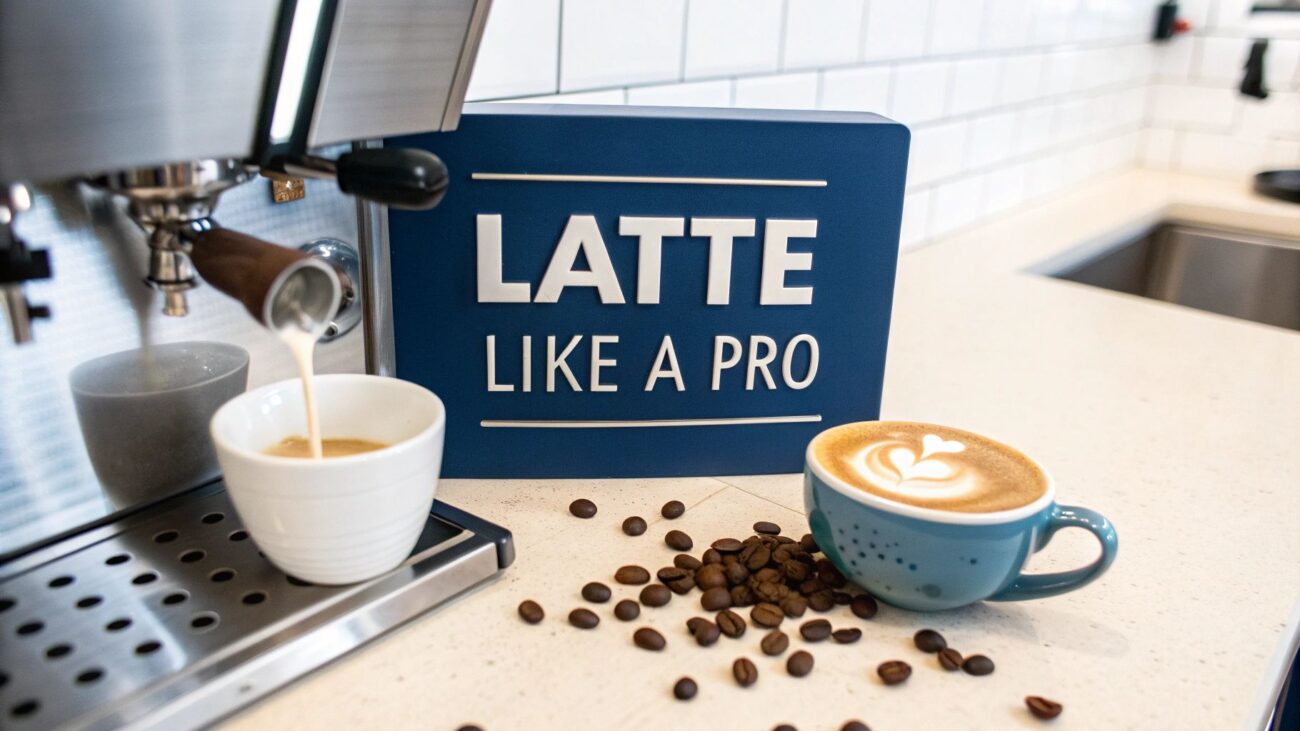How to Make an Americano Coffee Drink at Home
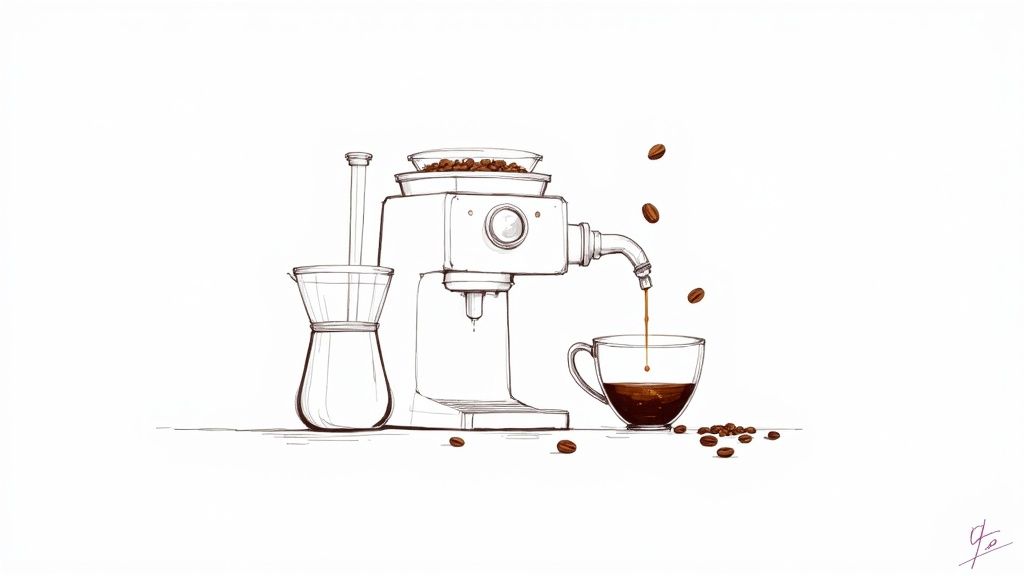
Mastering the Americano is a simple yet elegant art: pour hot water over a freshly pulled shot of espresso. It sounds easy, but the secret to transforming a good coffee into an exceptional one is all in the details.
This guide will walk you through everything, from picking the right beans to the final pour, so you can nail this classic drink at home.
The Enduring Appeal of the Americano
Too often, the Americano is unfairly dismissed as just a watered-down espresso. In reality, it's a wonderfully nuanced and satisfying drink with a fascinating history, offering all the complex flavours of a great espresso in a larger, more sippable format. It's no wonder it's a staple in cafés right across the UK.
The story goes that it was invented during World War II. American soldiers stationed in Italy found the local espresso a bit too intense, so they started adding hot water to make it more familiar. This quick adaptation stuck, eventually becoming a sophisticated choice for coffee lovers who want to appreciate the pure character of the beans. You can read more about the Americano's journey on kahwati.co.uk.
The beauty of the Americano is its simplicity. It’s a transparent drink, letting the quality of the espresso—the origin, the roast, the extraction—shine through without being hidden by milk or sugar.
To get it right, your foundation has to be solid. That means starting with beans that produce a rich, aromatic espresso. Exploring different specialty coffee beans is the first, and most important, step towards crafting an Americano that rivals your favourite coffee shop. Getting this classic right is a truly rewarding skill for any home barista.
Gathering Your Essential Tools and Ingredients
Before you even think about pulling that perfect shot, let's talk about your setup. You don't need a professional café taking over your kitchen to make a brilliant Americano, but a few key pieces of kit will completely change the game. Think of them as your partners in the craft.
The heart of the whole operation is your espresso machine. It doesn’t need to be a top-of-the-line monster; many home machines are perfectly capable of hitting the 9 bars of pressure required for true espresso. The most important thing is that it can hold a steady temperature and pressure while it works its magic.
Your Core Brewing Kit
Right up there with the machine is a decent grinder. I can't stress this enough: pre-ground coffee goes stale incredibly fast, losing all its beautiful, delicate aromas. Grinding your beans moments before you brew is non-negotiable if you want a cup bursting with flavour.
- Burr Grinder: This is your best friend. Blade grinders just smash beans into uneven bits, but a burr grinder mills them to a consistent size. This uniformity is absolutely critical for a balanced, even espresso extraction.
- Fresh Coffee Beans: The quality of your beans directly dictates the character of your Americano. Always start with freshly roasted beans and try to use them within a few weeks of the roast date for the best possible taste.
- Filtered Water: Your tap water is likely full of minerals and chlorine that can muddle the coffee's flavour. Using filtered water gives you a clean slate, letting the coffee's own unique notes come through clearly.
Your Americano will only ever be as good as its two ingredients: coffee and water. Investing in quality beans and filtered water is the single most effective way to elevate your drink.
Of course, you’ll also need a kettle for your hot water and a good, solid mug. Here’s a little pro tip: give your mug a quick rinse with hot water before you start. It’s a simple trick that keeps your drink at the perfect temperature for that little bit longer.
This basic setup is the foundation for countless coffee adventures. If you’re curious about other ways to make great coffee at home, you can explore our guides on how to brew coffee with different methods. Each piece of the puzzle plays its part in building a truly satisfying Americano.
Choosing and Grinding Your Coffee Beans
The soul of any great Americano is its espresso, and that all begins with the beans. This is your first real creative decision and one that will define the entire character of your drink. Go for a lighter roast, and you'll get an Americano bursting with bright, fruity notes. Fancy something more traditional? A dark roast will give you those classic, comforting flavours of chocolate and caramel.
Whatever you choose, always check the roast date on the bag. Coffee beans are at their absolute best within a few weeks of being roasted, so freshness is everything. Once you've got them home, knowing how to store coffee beans properly is vital to keeping those delicate aromas locked in.
This obsession with fresh, high-quality beans isn't just a niche thing anymore. Here in the UK, where we get through an astonishing 98 million cups of coffee every day, a massive 70.1% of coffee bought outside the home is proper roasted coffee. It just goes to show how much we value a quality starting point. You can dig into more of these stats over at Lavazza Professional.
Why Your Grind Is So Important
You've got the beans. Now comes what is arguably the most critical part of the whole process: grinding. If your espresso shot tastes disappointing, nine times out of ten, the grind is the culprit.
What you're aiming for is a fine, consistent grind that feels a little grittier than flour. This consistency is key because it forces the hot water to pass through the coffee puck evenly.
- Too coarse? The water will just gush through, leaving you with a sour, weak, under-extracted shot.
- Too fine? The water will struggle to push its way through, resulting in a bitter, over-extracted mess.
Think of your grinder as the flavour dial for your espresso. The smallest tweak can completely transform the taste in your cup, turning a failed shot into the perfect one. It’s the difference between a flat, lifeless drink and a vibrant, perfectly balanced Americano.
Getting the grind right is a bit of a balancing act, but it’s a skill you can master. To help you get a feel for it, here’s a quick guide to how grind size affects your brew.
Espresso Grind and Flavour Guide
This table shows you how adjusting the grind impacts the time it takes to pull a shot and, ultimately, the flavour of your Americano. Use it as your starting point for dialling in your grinder at home.
| Grind Size | Typical Extraction Time | Resulting Flavour Profile |
|---|---|---|
| Too Coarse | Under 20 seconds | Weak, sour, and acidic. Lacks body and depth. |
| Just Right | 25-30 seconds | Balanced, sweet, and rich with a pleasant crema. |
| Too Fine | Over 35 seconds | Bitter, burnt, and harsh. Can taste astringent. |
See that 25-30 second window? That's your target. If your shots are running too fast, tighten up your grind. If they're choking the machine and running too slow, coarsen it up a bit. Keep adjusting until you hit that sweet spot.
Pulling the Perfect Espresso Shot
Now for the best part—pulling the shot. With your beans ground and ready, this is where the magic happens. The espresso is the heart and soul of your Americano, and getting this stage right is what separates a decent coffee from a truly exceptional one. We're aiming for a rich, syrupy extraction that will serve as the flavour-packed base for the final drink.
Nailing the Dose and Tamp
First things first, let's get the coffee into the portafilter. For a classic double shot, a dose between 16-18 grams is the sweet spot. I can't stress this enough: use a scale. Eyeballing it just won't cut it if you want consistently great coffee every single time.
Once you've weighed your grounds, give the portafilter a gentle shake or tap to settle them evenly. A level coffee bed is crucial for avoiding channelling—that's when water punches a hole through a weak spot in the puck, resulting in a thin, sour shot. Nobody wants that. Tamp down with firm, even pressure. The goal is to create a compact puck that offers just the right resistance to the hot water.
This quick visual guide breaks down the essential steps, from pulling the espresso to adding the water.
As you can see, each step builds on the last, so taking a methodical approach really pays off in the final cup.
Watching for the Perfect Extraction
With your portafilter locked in, hit the brew button and keep your eyes peeled. What you want to see are a few dark, syrupy droplets that slowly come together into a steady, flowing stream. Baristas often call this a 'mouse tail' because of its shape and honey-like consistency—it's the tell-tale sign of a brilliant extraction.
The golden rule for a balanced shot is a 1:2 brew ratio. This means your final liquid espresso should weigh roughly twice as much as your initial dose of dry grounds. So, if you started with 18 grams of coffee, you're looking for about 36 grams of espresso in your cup, pulled over 25-30 seconds.
Mastering this takes a bit of practice, but it's a rewarding skill. If you want to dive deeper into the nitty-gritty of the process, our complete guide on how to make espresso at home is packed with more detailed tips and troubleshooting advice to help you perfect your technique.
Getting the Water Right: Ratio and Assembly
So, you’ve pulled a beautiful shot of espresso. Now for the final, defining touch: the water. How you handle this stage is what transforms that espresso into a proper Americano, and it directly shapes the final character of your drink.
The ratio of water to espresso is where you can really start to fine-tune things to your own taste.
A solid starting point for a classic Americano is a 1:2 ratio—that’s one part espresso to two parts hot water. If you’ve pulled a standard double shot weighing around 36 grams, you'd be looking to add about 72 grams (or millilitres) of water. This creates a really well-balanced, flavourful cup that still lets all the interesting notes of the espresso shine through.
Finding Your Sweet Spot
Of course, that ratio is just a guideline. This is all about what you enjoy, so feel free to experiment.
- Fancy something stronger? Try a 1:1 ratio. This keeps the drink robust and much closer to the original, intense flavour of the espresso.
- Prefer a milder, more sippable coffee? A 1:3 or even a 1:4 ratio might be perfect. This creates a much lighter-bodied drink, ideal for when you want to take your time.
Just as important as the ratio is the temperature of your water. Whatever you do, don't pour boiling water straight from the kettle onto your espresso. It will scorch the delicate coffee oils and leave you with a bitter, unpleasant taste. You're aiming for a temperature between 85°C and 90°C.
There’s a bit of a friendly debate in the coffee world about the best order to combine the two. Adding water to the espresso tends to mix the crema in, creating a more uniform body. Pouring the espresso over the hot water (a drink often called a Long Black) keeps that lovely layer of crema intact on top, giving you a richer texture.
Ultimately, there’s no right or wrong answer here; it all comes down to personal preference for texture and presentation. Each method gives you a slightly different experience, much like the variations you'll find across the best coffee brewing methods. Have a go at both and see which one you prefer when making an Americano at home.
Refining Your Americano Making Technique
Once you’ve got the basics down, the real fun begins. This is where you move from just following a recipe to truly crafting a coffee that’s perfect for you. Even tiny tweaks can have a massive impact on the final taste.
One of the simplest, yet most effective, habits to get into is pre-heating your mug. Just give it a swirl with hot water from the kettle and tip it out right before you start. This stops the cold ceramic from instantly dropping the temperature of your espresso, keeping your drink warmer for longer. It’s a small step, but it makes a world of difference.
Troubleshooting Common Flavour Issues
Ever made an Americano that just tastes… off? Don't worry, it happens to all of us. If you’re getting a sharp, sour tang, that’s a tell-tale sign of under-extraction. On the flip side, a harsh, overly bitter flavour usually points to over-extraction.
Before you blame the beans, check your technique. It’s usually a simple fix.
- Sour Taste? This usually means the water shot through the coffee grounds too quickly. Try making your grind a little finer to slow things down.
- Bitter Taste? This suggests the water lingered with the coffee for too long. Coarsening the grind slightly will help speed up the flow.
Think of these flavours as direct feedback from your coffee. Your palate is telling you exactly what needs adjusting, giving you the power to dial in that perfect shot.
Exploring Popular Americano Variations
Happy with your classic Americano? Great! Now you can start playing around. The beauty of this drink is its versatility.
On a hot day, nothing beats an Iced Americano. Simply pull your double espresso shot straight into a glass packed with ice, then top it up with cold water. It's that easy.
Another fantastic twist is the Long Black, a staple in Australian and New Zealand coffee shops. Here, you just reverse the process: fill your mug with hot water first, then gently float the espresso on top. This technique preserves the delicate crema, giving you a slightly more aromatic and fuller-bodied drink.
A Few Common Questions About the Americano
Even with a solid recipe, a few questions always seem to come up when you’re getting the hang of a new coffee drink. Let’s clear up some of the most common queries I get about making a great Americano at home.
What's The Real Difference Between an Americano and a Long Black?
Honestly, it all comes down to one simple thing: the order you combine the ingredients.
For a traditional Americano, you pour hot water directly onto a freshly pulled espresso shot. This tends to mix the crema right into the drink, creating a very uniform body.
A Long Black, on the other hand, flips the script. You pull the espresso shot and pour it over the hot water. The whole point of doing it this way is to keep that beautiful, rich layer of crema floating on top. Many people find this gives the drink a fuller texture and a more aromatic first sip.
Can I Make an Americano Without an Espresso Machine?
Absolutely. While a proper espresso machine is the gold standard, you can get remarkably close with other brewers. The key is to create a strong, concentrated coffee base.
A Moka pot is a fantastic and affordable option, as is an AeroPress. If you use one of these, brew a small, potent "shot" of coffee and then add hot water, sticking to that same 1:2 ratio. You might miss out on the signature crema, but the bold, rich flavour will be right there.
Don’t get hung up on equipment. The goal is a well-balanced, diluted coffee concentrate. A Moka pot shot topped up with hot water is a much better substitute than just a weak, watery brew from a drip machine.
Why Does My Homemade Americano Taste Sour or Bitter?
This is the big one. If your Americano tastes off, the culprit is almost always the espresso shot itself. Getting the extraction right is the single most important part of the process.
Think of it like this:
- A sour taste means your coffee is under-extracted. The water shot through the grounds too fast. The fix? Grind your beans finer.
- A bitter taste points to over-extraction. The water lingered with the coffee for too long. The solution here is to use a slightly coarser grind.
It’s also worth checking your water temperature. Water straight off the boil can easily scorch the delicate coffee grounds, leaving you with a harsh, burnt flavour. Always give the kettle a moment to cool down after it clicks off.
At Seven Sisters Coffee Co, we believe the best Americano starts with the finest beans. Explore our curated selection of freshly roasted, single-origin coffees and discover the perfect foundation for your next brew. Find your new favourite at https://sevensisterscoffee.co.uk.




